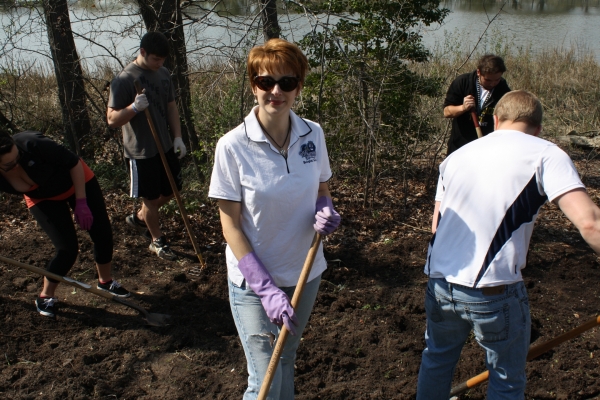Monarchs for Monarchs: ODU Joins in Nationwide Effort to Stabilize Butterfly Population
April 14, 2014
 Tatyana Lobova, biology lecturer, is leading the Monarchs for Monarchs effort at ODU.
Tatyana Lobova, biology lecturer, is leading the Monarchs for Monarchs effort at ODU.
"We need all of those vines cut away from the plot. But be careful with that machete!"
Marcus Jones, greenhouse conservator with Old Dominion University's Arthur and Phyllis Kaplan Orchid Conservatory, hands a 10-inch blade to a student volunteer. That student takes a few steps down the bank of a grassy area next to Colley Bay on 49th Street, and starts carefully hacking away at thick, hanging vines.
Beneath their feet, an area of grass is outlined with washable white paint. In that oblong area, students attack the earth enthusiastically with rakes and spades, removing branches and grass, and turning soil. A few feet away, parked on the street, is a pickup truck with its bed completely filled with seedlings ready to be planted in the freshly turned earth.
They're native milkweed plants, and they're being planted in this and other locations around the ODU campus as part of an innovative program to help migrating monarch butterflies.
It's called the "Monarchs for Monarchs" program, a partnership among the biological sciences department of the College of Sciences, ODU student botanists, the Orchid Conservatory, the ODU grounds department and Norfolk Botanical Garden.
"There's a whole movement in our community to support one of nature's true wonders," said project coordinator Tatyana Lobova, lecturer of biology in the College of Sciences. "And this project provides a wonderful opportunity for us on a number of levels."
Milkweed plants, which are native to the area, provide perfect habitat for monarch butterflies as they complete a multigenerational migration each fall and spring, traveling thousands of miles to and from wintering grounds in Mexico. Milkweed provides both food and habitat for the beautiful insects, and causes the monarchs - so named because they are considered to be the "king" of the butterflies - to secrete a toxin that makes them poisonous to predators, such as birds.
However, the population of monarch butterflies making the massive journey has declined sharply. The Monarchs for Monarchs program is part of a nationwide initiative to help the butterfly population stabilize. It's especially important here, because Norfolk and ODU are right on one of three main flyways the butterflies take on their migration, Lobova said.
"We don't want to lose this magnificent event. At the very least, we want to do what we can to supplement the population," she added.
On a recent gorgeous spring day, two dozen students in ODU sweatshirts and jeans prepared the plot of land by Colley Bay, planted the milkweed seedlings and watered them. The volunteers included employees of the ODU grounds department, students in an ecology class taught by Rachel Schroeder and members of the Botanical Society of America ODU student chapter. Students from an entomology class taught by Debbie Waller, associate professor of biology, cleaned trash from the site earlier in the day.
Tim Hammer, a master's student in biology and president of the chapter, said the program provides both a great lesson for students and a chance to make a difference, all while getting your hands a little dirty.
"We're taking native plants and reintroducing them into the local environment, and helping monarch butterflies, which is really cool," Hammer said.
Cassie Davis, a sophomore psychology major from Charleston, W.Va., responded to the ad to volunteer for the clearing and planting expedition. "I thought it was a neat opportunity to do something fun and active, and help out butterflies. They're so beautiful, and if there's anything we can do, we should," she said.
The project will also help more than butterflies.
Lobova said the plots around campus will be filled with different species of milkweed plants, mostly native, but also some exotic, noninvasive varieties. Student biologists will take measurements of insect interaction with the plants, test the plants' hardiness and ease of care, and glean other information that could be of interest to local planters.
"We want to test to see what plants would be good, in terms of insect attraction, hardiness, beauty and ease to grow," said Lobova, who is also director of science at Norfolk Botanical Garden. "If we can figure out what plant works best, we can spread that message through the Norfolk Botanical Garden and by collaborating with local plant nurseries. Hopefully local residents can help this effort, too.
"It's also a lesson in sustainable ecology for the students, because these are native plants we're reintroducing," she added.
The milkweed plantings will be done over the next few weeks. Monarch butterflies typically don't show up in Norfolk until summer, after these plants will have taken root and started to grow. The butterflies that arrive here in the early summer are making their way back from their wintering grounds in Mexico. Monarch butterflies also leave and pass through the region during their fall migration south down the Atlantic Coast and west across the Gulf Coast.

